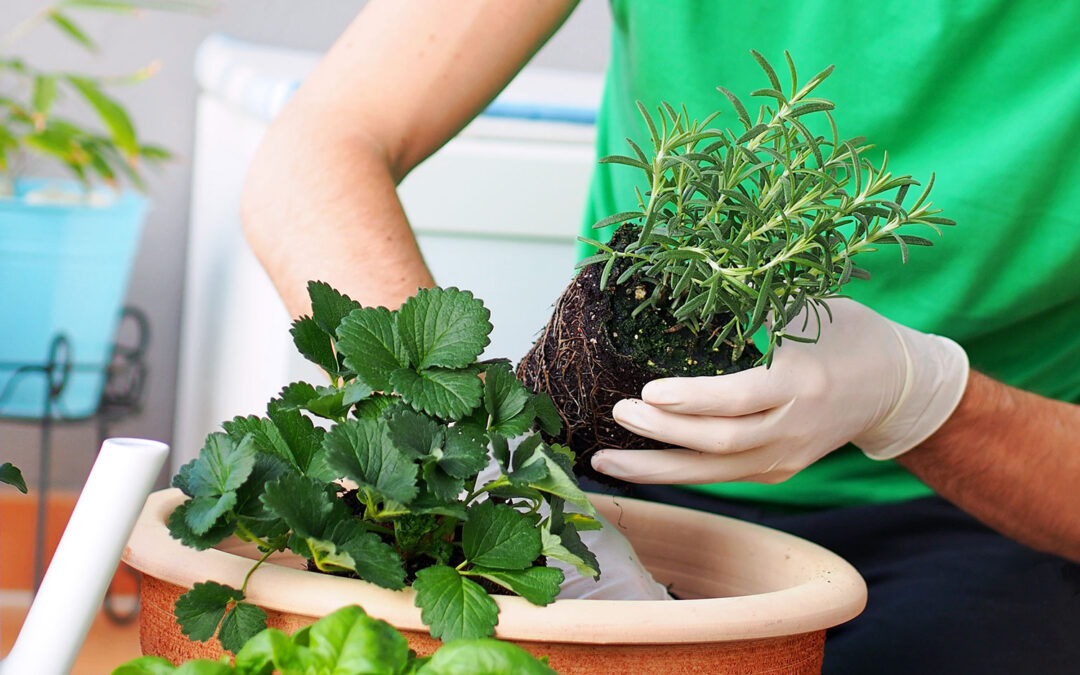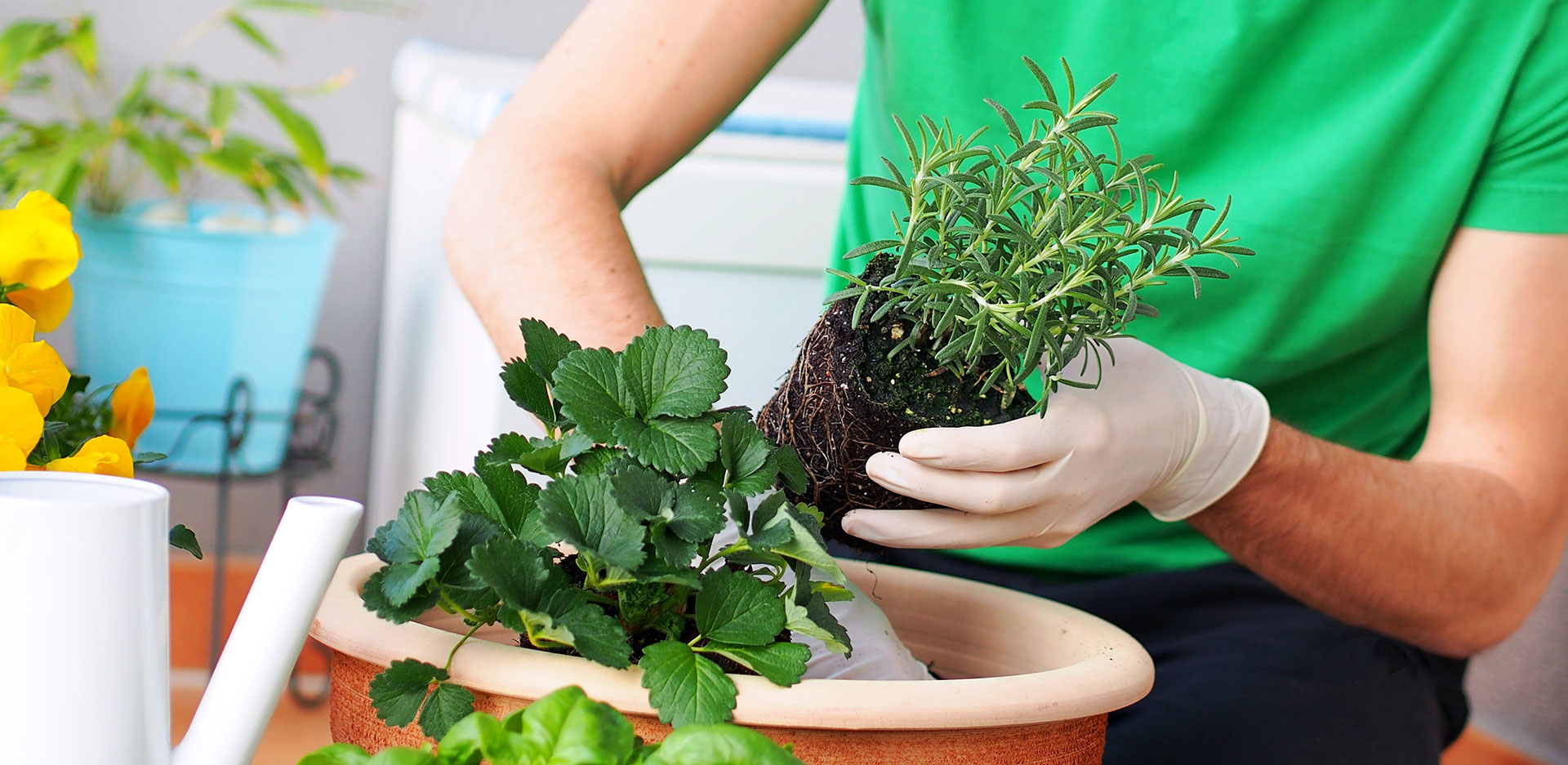All Herbs Love the Heat, Right?
Wrong. Not all herbs are natural summer lovers. In fact, several types enjoy cooler temperatures, such as:
- Cilantro
- Parsley
- Chives
- Chervil
- Sorrel
So, which herbs enjoy the heat?
- Lemongrass
- Basil (Everyone’s favorite!)
- Rosemary
- Tarragon
- Thyme
- Dill
- Borage
- Bay
- Mint
- Oregano
It’s important to note that even summer-loving herbs will need extra TLC to get them through the hottest months. Without the proper care, your herbs could be left sunburnt, taste-deficient, and withering. How can you make a success of it?
A Pre-Summer Precaution
Your goal: Keep the roots cool. So, avoid planting your precious herbs in dark or metal containers. Why? Dark colors absorb the sun’s rays, heating up the soil. And, if you’ve ever leaned against a hot car while in your “Daisy Duke’s,” you can guess what damage a metal pot can do!
Watering Your Herbs in the Summer
Adjusting your watering routine to fit warmer temperatures can be an adventure. You may think hotter temperatures = a thirstier plant. And, while that may be the case, keeping that theory too close in mind can also contribute to overwatering. Two rules for summer watering: Always check the soil’s moisture level and water deep.
If you frequently give your herbs a quick, daily spray-down (surface watering), you’re encouraging them to develop shallow roots. What’s the problem with that? When the heat of summer comes, a plant needs deep roots to keep cool and remain hydrated. How do you “water deep”?
- Container gardens: Drench the soil until water drains from the bottom for 2 minutes.
- In-ground gardens: Drench for 15 minutes.
While watering deeply takes more time, you don’t have to water as frequently and achieve healthier (tastier) herbs. What’s not to love?
When to Water
We love taking a midday dip in the pool, right? So our plants must love a mid-day spray-down! Nope, think again. Water droplets on your herb’s leaves act as mini magnifying glasses, amplifying the sun’s rays (making your wilty plant even “wilty-er”). Solution? Do your deep watering at the end of the day, when the sun is setting, and temperatures are cooler.
Preparing for a Heatwave
Sudden, shockingly hot temperatures can send some plants into a type of survival-mode-hibernation, where they temporarily stop absorbing moisture and nutrients through their roots. What can you do?
Watch the weather and thoroughly water your garden before the heatwave hits. This will give your herbs what they need to see them through! (Who wants to hibernate on an ‘empty stomach,’ right?) Rewater your plant friend when the soil exhibits the proper signs, remembering that this could happen more slowly than you expect.
Ways to Keep it Cool!
Container Gardens
One of the many perks of container gardens: If a location proves to be too hot or sunny, you can quickly relocate your herbs! Are some of your cool-weather herbs suffering? You can
opt to bring them indoors for the hottest part of the summer. How? Taking plants directly from the midday sun to an air-conditioned house is shocking, to say the least! So, prepare your plant by first placing it in a shady location. In a few days, when temperatures have cooled at night, bring your herb indoors.
One of the downsides: if your container is too small, your plant’s root system isn’t very well insulated from the heat. What can you do? Before the hottest days of summer arrive, make sure your plant isn’t rootbound. If it is, give it a pot upgrade!
In-Ground Gardens
The bad news: your herbs are pretty much stuck with their location. But, there are a few things you can do to help your plants thrive in the heat. Give your herbs a thick layer of mulch to provide added insulation to the soil. Remember, cool roots contribute to a happy plant!
Consider providing your herbs with some much-needed shade, especially from the afternoon sun! How can you do this? There are several ways, ranging from “bootleg” ideas to more polished looks. You can simply move your patio umbrella to the garden. You could rig up one of those (million) Amazon boxes you have. Or you can invest in some shade cloth.
If you’re opting for shade cloth, here are a few things to keep in mind: (1) You need 30% to 40% shade, (2) Dark colors absorb heat, so you’ll need to keep black shade cloths several inches from your herb’s foliage.
Keep Pruning
Warm temperatures give many herbs the “green-light” to flower and bolt. What’s the big deal about that? Bolting negatively impacts the flavor and texture of some herbs. And, let’s admit it, bolted Cilantro is just sad. Prevent your plant from bolting by regularly pruning new growth and removing any flowers ASAP.
Are you at a loss about what to do with all these extra herbs? Keep your eyes peeled for more of our articles with herb-ilicious recipes. And save some of this summer-freshness for the upcoming winter months by making “herbal ice cubes.” Simply fill the bottom of an ice cube tray with your minced herb of choice, top with some olive oil, and stick it in the freezer!
—
Whatever temperatures this summer brings, by using these helpful tips, we trust that you and your herbs will be able to “beat the heat!” Happy Growing!



Any tips on lavender? When I plant lavender in my garden area, it usually dies in the same season. Does it like the heat too?
First I suggest that you get perennial lavender plants that will grow in your growing zone. You may have to experiment to find the right one. You also need to plant in a soil that drains well as the lavender plants don’t do well in soil that holds moisture. You will notice that you are doing it right when the plant grows, flowers and lasts during the cold seasons. ( or the weather by your area). Lavender plants will grow well if you have the right ones. I am in the grow area 7 and grow Lavender in container pots. My neighbor tried to plant in their front yard and it never grew well until they tried doing it in a container pot. Different areas encourage different plants.?Good luck
I have lavender that is in direct sun all day long and lots of wind from the sea breeze. I found it is all about planting the right type. In my area, there are two types that are perfect. When I get gifted others, they just don’t make it. Try types that better fit your climate…just a bit of free advice.
Phoenix, Arizona we had temps of 119F and the sun is so bright, it’s like a microwave. We plant our herbs on the North side of the house where they receive morning sun only and mind you these are “Full Sun” plants. Basil, Lavender, several others- thrive in the partial shade. I flood my plantings and mist them during hot days, but only if they are in the shade at the time.
Your article is a bushel of useful info. The Pacific NW has had record breaking extreme heat. Mostly container gardening, will use your advice to do deep watering late in the day about sunset. Really appreciate it.